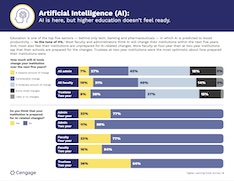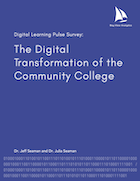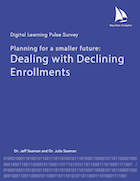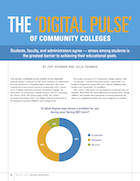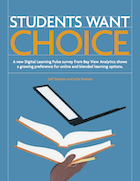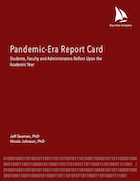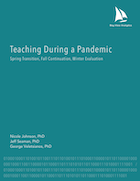Digital Learning Pulse Surveys
The higher education industry navigated many challenges beginning in 2020 and continuing into 2023, beginning with the emergency transition to online learning in the face of the COVID-19 pandemic. Bay View Analytics has partnered with leading organizations to track the impact of these transitions on administrators, faculty, and students. This ongoing series has already conducted seven rounds of surveys.
The first four rounds of the project covered Spring 2020, Fall 2020, Winter 2020, and Spring 2021. These studies were done in partnership with the Online Learning Consortium (OLC), WICHE Cooperative for Educational Technologies (WCET), University Professional and Continuing Education Association (UPCEA), the Canadian Digital Learning Research Association (CDLRA), and primary partner and underwriter Cengage.
The second wave of surveys (Fall 2021 and Spring 2022) added a focus on two-year institutions while still examining the overall higher education landscape. Cengage continued as the primary partner and underwriter. Partners included the Association of Community College Trustees (ACCT), Achieving the Dream (ATD), Phi Theta Kappa (PTK), the Online Learning Consortium (OLC), the Higher Education Research & Development Institute (HERDI), and College Pulse.
The most recent round of data collection was conducted during Fall 2022, with an additional round planned for Fall 2023. Partners for the project are the Association of Community College Trustees (ACCT), Phi Theta Kappa (PTK), the Higher Education Research & Development Institute (HERDI), and College Pulse. Cengage is the primary partner and underwriter.
Presentation: Online Learning Consortium Innovate 24
Faculty Predict the Future (and learn from the past)Date: April 23, 2024
Faculty believe that their teaching has changed massively since the beginning of the pandemic. They are increasingly embracing technology in their teaching, whether at a distance or in person. However, faculty don't think we have reached the end of these changes - they expect even more in the coming years.
This session presents faculty views - what they believe has changed, what has not, and what they think the future will hold. Has the glow dimmed for online teaching? In what ways will Artificial Intelligence change teaching? Do faculty think their institution is ready for these changes? How optimistic are faculty about their personal future? About the future of their institution? What barriers do they think their students are facing?
Download presentation slides (PDF)
Inside Higher Ed Webinar: What’s Ahead in Higher Ed: AI, Enrollment & Wellness
Download presentation slides: What’s Ahead in Higher Ed (PDF)On-demand access to the webinar
Project: Infographic
While Generative AI could ease ongoing challenges in education, just 1 in 5 Digital Learning Pulse Survey responders say their institution is ready for the changes that it will bring to higher education. The webinar provides valuable insights from the latest Digital Learning Pulse Survey and improve your strategies in areas such as AI, enrollment and campus wellness.
Topics covered:
- Sentiments around the amount of in-person, hybrid and online offerings as enrollment concerns persist at two- and four-year institutions.
- The anticipated impact of AI and the level of readiness felt by administrators, faculty and trustees.
- The feelings students have about institutional support services dedicated to helping them deal with stress.
Speakers:
Jeff Seaman, Ph.D., Director, Bay View AnalyticsKim Russell, Vice President of Research, Cengage
Josh Kim, Director of Online Programs and Strategy, Dartmouth College
Fall 2023
While three-quarters of higher-education trustees (83%), faculty (81%) and administrators (76%) agree that generative artificial intelligence (GenAI) will noticeably change their institutions in the next five years, community college trustees are more optimistic than their community college counterparts, with (37%) saying their organization is prepared for the change coming compared to just 16% of faculty and 11% of administrator respondents. These findings are from the 2023-2024 Digital Learning Pulse Survey conducted by Cengage and Bay View Analytics with support from the Association of Community College Trustees (ACCT), the Association of College and University Educators (ACUE), College Pulse and the United States Distance Learning Association (USDLA) to understand the attitudes and concerns of higher education instructors and leadership.- Courses largely make the grade: Most students at both two- and four-year institutions give their courses a grade of A (48%) or B (39%). Overall, the number of students giving their courses A grades has trended upward, increasing 20% since 2020. Students at two-year institutions who graded their courses highly trended downward during that same time, dropping approximately 10%.
- Rising costs weigh heavily: The rising cost of education is a concern across the board with more than a third of each respondent group – 41% of administrators, 46% of faculty, 35% of trustees and 33% of students – strongly agreeing that the price of a two- or four-year program is becoming out of reach.
- The stress is real: Stress dominates the list of concerns of students, faculty and administrators alike. For students, however, nearly one in three (30%) said they were unaware of support services available to them through their school, and fewer than 1 in 4 (22%) report having used such services. The most common reason for not using these services was students "did not think they could help my personal situation" (34%), followed by being uncomfortable sharing personal information (29%).
- Academic advisors offer value: Most students find value in the academic advisory services provided by their institution, with more respondents from two-year institutions (34%) describing their academic counseling as "excellent," compared to those from four-year institutions (25%). Students felt less positive about other services offered, including financial services (24%), and health and wellbeing services (24%).
Digital Learning Pulse Survey Research in the News
- Like a Good Student, AI Is Getting Smarter Inside Higher Ed
- Equipping Educators for the Age of Artificial Intelligence Visible
- Study Reveals Only 16% of Faculty is Ready for GenAI in Higher Education Diverse
- Higher ed is unprepared for GenAI’s impact eCampus News
- Survey Suggests Higher Ed Institutions Are Not Ready for Generative AI Campus Technology
- Digital Learning Pulse Survey Reveals Higher-Ed Unprepared for Expected Impact of AI Aithority
- Emergency Remote Instruction Is Not Quality Online Learning Inside Higher Ed
- Community College Students Want More Flexibility, Technology in Their Courses Campus Technology
- Report: Despite struggles, pandemic-era online learning holds promise for student-centered learning K-12 Dive
- Student Performance in Remote Learning, Explored (Imperfectly) Inside Higher Ed
- Education's Hybrid Future: What We Know from Research Campus Technology
- 73 Percent of Students Prefer Some Courses Be Fully Online Post-Pandemic Campus Technology
- Students Want Online Learning Options Post-Pandemic Inside Higher Ed
- Nearly Half of Faculty Say Pandemic Changes to Teaching Are Here to Stay Campus Technology
- Attitudes About Homeschooling May Get Unexpected Boost From a Year of Remote Learning EdSurge
- College faculty see increased value in digital learning University Business
- Pandemic Spurs Changes in the Edtech Schools Use, From the Classroom to the Admin Office EdSurge
- Half of Faculty 'Strongly' Agree They're Ready for Online Classes this Fall Campus Technology
Previous Reports
Fall 2022
The Digital Transformation of the Community College by Bay View Analytics shows that digital transformation is wide-ranging and fundamental among US Community Colleges. Based on data from the Digital Learning Pulse Survey, the report confirms the pervasive nature of digital learning changes from student, faculty, and administrative perspectives.Key takeaways:
- Community colleges continue to increase the use of digital tools and technology in their courses, driven by a belief that these tools have been effective for student learning.
- Faculty and administrators are calling for more technology use in the future, including in fully in-person courses.
- There is growing optimism toward digital materials among students, faculty, and administrators. As a result, faculty and administrators plan to include even more digital materials.
- Community college students reported being more optimistic about online learning (56%) and blended learning (50%) than before the pandemic. Faculty reported being more optimistic about online learning (52%) than pre-pandemic.
- Students have a growing desire to take more online and blended courses stemming from their satisfaction and optimistic attitude about their online learning experiences.
- A return to the pre-pandemic "normal" is unlikely. Faculty report that the changes in teaching practices will continue without a wholesale return to their pre-pandemic approaches.
The Bay View Analytics report Planning for a Smaller Future: Dealing with Declining Enrollments from the Digital Learning Pulse Survey project shows concerns about future enrollments are pervasive across all of higher education. More than 80% of administrators expressed concern about future enrollments, with administrators at two-year institutions expressing higher levels of concern about future enrollments than those at four-year schools.
Key takeaways:
- Virtually all institutions are providing more courses online or in hybrid formats to address their enrollment concerns. Over 80% of institutions say they have already or will soon move more courses to online delivery. A similar proportion of institutions reported that they have or will soon move more courses to hybrid delivery.
- The majority of institutions are revising existing programs to improve student retention and attract more students. About one-half of institutions have already started both efforts, with about an additional 40% reporting that they are planning to do so.
- Over 60% of institutions are either offering or planning to offer a micro-credential program. A similar number say that they have added programs designed for "stopped-out" students (those who attended a college but did not receive a degree).
- Institutions are engaging multiple strategies to attract additional students.
- Inside Higher Ed webinar recording: Covering how attitudes and perspectives on digital teaching and learning have shifted from the start of the pandemic; how student, faculty and administrative leaders in both two- and four-year institutions feel about their experiences today; and how to effectively support digital teaching and learning. The expert panel will share their perspectives on the findings and personal stories of their own experiences. Admin, Faculty and Student Perspectives on Digital Learning in Fall 2022
- Webinar slides: Admin, Faculty and Student Perspectives on Digital Learning in Fall 2022
- Infographic: Cost, Value and Enrollment Concerns on Today’s Campuses
Spring 2022
As higher education transitions to a new normal following the pandemic, one aspect community college students don't want to give up is access to online courses. The research found that three-quarters of community college students (76%) want to take some courses fully online in the future, up from 68% in the Fall of 2021.Key takeaways:
- Students are more positive about their learning experiences in Spring 2022 vs. Spring 2021. More two-year students (53%) gave their Spring 2022 learning experience an "A" compared to only 40% in Spring 2021.
- Regardless of the current course format, students want to take more courses fully online in the future. Eighty-eight% of students are currently in online courses; 60% of students are currently in in-person courses, and 76% of students in hybrid courses want to take at least some courses fully online in the future.
- Stress is the single most pressing issue for students. Half (49%) of community college students felt stress was a big problem for them, followed by financial issues (31%), level of motivation (29%), and family and health issues (25%).
- Institutions need to do more to increase awareness of and use available student support services. Nearly 4 in 10 (38%) community college students were unaware if their institution offered support services. While more than half of students (57%) were aware of their institution's services, only 15% had actually used such services.
- ACCT Trustees Quarterly: The Digital Pulse of Community Colleges
- Inside Higher Ed webinar recording: Evolving Digital Learning in Community Colleges
- Webinar slides: Student, Faculty, and Administrator Perspectives on Digital Learning in the Community College
- Infographic: Student, Faculty, and Administrator Perspectives on Digital Learning in the Community College
Fall 2021
Community colleges serve a higher number of marginalized student populations, making it particularly concerning that enrollment at community colleges has dropped by nearly 15% since the pandemic began. The research found that most community college students today take online or hybrid courses, and the majority give their learning experience good marks. Regarding how community college students want to learn in the future, most say they want more digital options and at least some courses fully online.Key takeaways:
- In-person learning increased: While the majority of two-year students today take online or hybrid classes (78%), more students are taking only in-person classes in Fall 2021 (22%) compared to Spring 2021 (14%).
- Students give higher marks for learning experiences in Fall 2021 vs. Spring 2021. Nearly half (48%) of all students gave Fall 2021 learning an "A" grade, compared to 40% "A" grades for Spring 2021.
- Students more satisfied with in-person learning but want flexibility: Students who are taking in-person-only courses were more likely to give their learning experience an "A" (59%), compared to students in online courses (44%) and those in hybrid courses (49%). However, students taking only in-person courses reported more problems with work and technology.
- Students report less well-being than faculty or administrators: 62% of students reported having a feeling of personal well-being compared to 80% of faculty and 82% of administrators.
- Majority of students prefer some courses fully online and want more digital tools. The majority of two-year students (68%) want to take some courses fully online post-pandemic. 63% of students want more digital materials and resources in their courses.
- ACCT Trustees Quarterly: Students Want Choice
- Inside Higher Ed webinar recording: Perspectives on Impactful Digital Learning in Community Colleges
- Webinar slides: Perspectives on Digital Learning in the Community College
- Infographic (two-page): Perspectives on Digital Learning in the Community College
- Infographic (full length): Perspectives on Digital Learning in the Community College
Spring 2021
As students, faculty and administrators reflect on the 2020-21 school year, the majority give pandemic learning a decent grade.Key takeaways:
- Students, faculty, and administrators are aligned on key student challenges: Students, faculty, and administrators all agreed that "stress," "level of motivation," and "having time to do coursework" were students' top challenges.
- More students give pandemic learning an "A" grade compared to faculty or administrators: Students, faculty, and administrators graded how well their courses met education needs during Fall 2020 and Spring 2021, with more students giving "A"s, and more faculty and admins giving Bs.
- Students more positive about online learning: The majority of students are more optimistic in Spring 2021 than pre-pandemic about online learning (57%) and digital materials (52%). Nearly half of students (48%) are more optimistic about hybrid courses.
- 46% of students strongly agree; 27% somewhat agree that they want some courses delivered fully-online post-pandemic.
- Inside Higher Ed webinar recording: One Year Later – Reflecting on Higher Ed Digital Learning
- Webinar slides: One Year Later – Higher Education Students, Faculty, and Institutions Reflect on Digital Learning
- Report: Pandemic-Era Report Card
- Infographic: Pandemic-Era Report Card: Students, Faculty and Administrators Reflect Upon the Academic Year
- University Business article: Online learning gets A, B grades from students, faculty, administrators
- Campus Technology article: 73 Percent of Students Prefer Some Courses Be Fully Online Post-Pandemic
- Inside Higher Ed article: Students Want Online Learning Options Post-Pandemic
Winter 2020
Half of faculty (51%) are more positive about online learning during Winter 2020 than pre-pandemic. Most faculty (71%) said their teaching in Fall 2020 was "very different" or included a "number of changes" and almost half (47%) expect those changes to remain post-pandemic.Key takeaways:
- Digital materials use has soared: pre-pandemic, only 25% of institutions made considerable use of digital materials; for Fall 2020, 71% reported considerable use of digital.
- Online homework and courseware systems use more than doubled: pre-pandemic, only 22% of institutions made considerable use of online homework or courseware systems; 58% report considerable use of them for Winter 2020
- The majority of faculty are more positive about digital learning materials and online learning: 57% of faculty are more positive about digital learning materials, and 51% are more positive about online learning than pre-pandemic.
- Faculty have radically changed teaching techniques since the pandemic, and don't expect to revert: 71% of faculty said their teaching in Fall 2020 was either "very different" from pre-pandemic methods or included a "number of changes," and only 8% expect to revert to pre-pandemic practices.
- Report: Teaching During a Pandemic
- Infographic: Insight on the Post-Pandemic College Classroom
- CampusTechnology Article: Nearly Half of Faculty Say Pandemic Changes to Teaching Are Here to Stay
- University Business Article: College faculty see increased value in digital learning
- EdTech Article: A Year into the Pandemic and the Great Online Learning Experiment – Will Edtech Stick?
Fall 2020
U.S. higher education faculty and administrators agree that they are prepared to teach online for the Fall 202 term. While questions remain, they are optimistic about the future of higher education.Key takeaways:
- The overwhelming majority of faculty (84%) and administrators (96%) agree that they are prepared to teach online for the Fall 2020 term.
- Faculty at two-year and four-year private colleges feel more prepared to teach online than faculty at four-year public institutions – 88% versus 81%.
- Faculty and administrators at all institutions had access to multiple types of professional development – webinars, self-paced trainings, online resources, and more – and found them to be effective.
- Inside Higher Ed webinar recording: Higher Ed’s Responsive Strategies to COVID
- Webinar slides: Higher Ed's Responsive Strategies To COVID Bring About Faculty Confidence and Optimism
- Infographic: Higher Education Readiness for Teaching Online
- Inside Higher Ed article: College Faculty and Administrators Feel Prepared to Teach Online This Fall
Spring 2020
U.S. higher education leaders and practitioners reported that nearly all (90%) higher education institutions used some form of emergency distance education to complete the Spring 2020 term. The research also indicated emergency online instruction differs from a pre-planned fully online course. Even experienced online instructors had to improvise as they went along, with more than one-half using new teaching methods for these newly online courses.Key takeaways:
- Almost all institutions (97%) moving classes online had to call on faculty with no previous online teaching experience.
- A majority of faculty (56%) who moved courses online were using teaching methods they had never used before.
- Faculty had to adjust their courses to complete them online. While only a few faculty (17%) made changes to required readings, roughly one-half (48%) reduced the amount of work they expected. About one-third (32%) lowered their expectations for the quality of student work.
- Inside Higher Ed webinar recording: The Great (Forced) Shift to Remote Learning
- Webinar slides: The Great (Forced) Shift to Remote Learning: a Survey of Instructors and Campus Leaders
- Infographic: Higher Education’s Response to the COVID-19 Pandemic
- Inside Higher Ed article: How Teaching Changed in the (Forced) Shift to Remote Learning
- Research Brief: Faculty and Administrative Comment Analysis
- Online Learning Journal U.S. Faculty and Administrators' Experiences and Approaches in the Early Weeks of the COVID-19 Pandemic
Recent Publications
Digital Learning Pulse Surveys
- Infographic: 2023-2024 Digital Learning Pulse Survey
- The Digital Transformation of the Community College
- Planning for a Smaller Future: Dealing with Declining Enrollments
Course Material Affordability
- Pennsylvania Course Materials Survey 2023
- Pennsylvania Course Materials Presentation
- Course Material Webinar Slides
Open Educational Resources
- Digitally Established: Educational Resources in U.S. Higher Education, 2023
- Curricula of Many Sources: Educational Resources in U.S. K-12, 2023
- Research Brief: Digital and OER Textbook Adoption
- Research Brief: Faculty Satisfaction with Course Materials varies by Publisher
STEM
- Teaching Online: STEM Education in the Time of COVID
- What Makes a STEM Student
- Perceptions of the Future of STEM Education
Distance Education
- Digital Faculty: Faculty Social Media Use and Communications
- Infographic: Digital Faculty
- Grade Increase: Tracking Distance Education in the United States
Follow us on
Privacy
All survey respondents are provided complete anonymity. No personally identifiable information is released. Full privacy policy.
